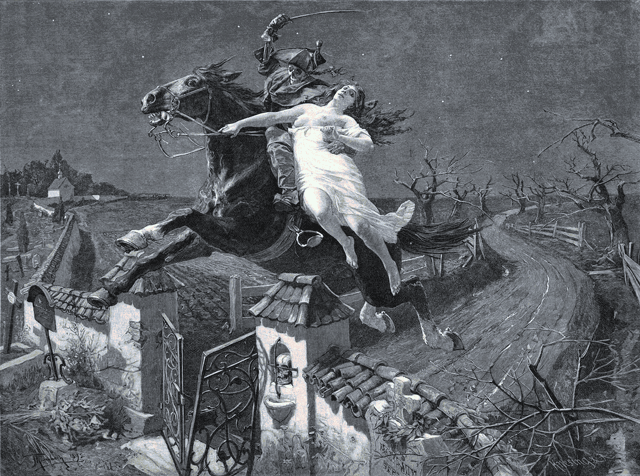Programme details
Dvořák - The Spectre's Bride

Antonín Dvořák
For his work, Dvořák chose the ballad Svatební košile (which literally translates as The Bride's Nightgown) by the Czech poet Karel Jaromír Erben (1811 - 1870). Erben's Kytice (Bouquet) collection of fairy tales inspired Dvořák more often, for example for his cycle of symphonic poems, The Water Goblin, The Noon Witch, The Golden Spinning Wheel and The Wild Dove. In these four poems, as in The Spectre's Bride, Dvořák assigns specific musical themes and even instruments for important characters and events in the drama. For example the bass clarinet, a new invention at the time, is always reserved for spooky, ghastly moments in the story.

Illustration for The Spectre's Bride
The ghostly ballad Svatební košile is a turmoil of emotions encompassing longing, horror, hope, doubt and, at the end, relief. The tale told is one of a wild and furious nocturnal hunt, through sludgy swamps and over bare rocks, passing by gloomy, glimmering will o' the wisps and dogs howling threateningly.
Synopsis of the 'plot'
In the opening soprano monologue the girl thinks of her beloved who left to travel abroad. She prays to the Virgin Mary that he return safely and, at the end of the scene, expresses the blasphemous thought that, if he did not return, she would rather die. Then a living corpse appears at the parlour window, pretending to be the girls beloved, and he invites her to his home. She then sets out with him on a terrible journey on a flying horse through the night landscape, during which the dead man gradually throws away the objects the girl has taken with her: a little cross, a rosary and a prayer book. The couple finally arrive at the place the corpse calls his home - a cemetery. It is only now that the girl realises her mistake and she is saved by uttering a prayer of apology to the Virgin Mary and by the appearance of the first rays of the sun announcing the new day.
Structure of the composition
The form of the cantata was determined by the nature of the text: the dialogue between the girl and the corpse is sung by solo soprano and tenor; the role of the narrator is entrusted to the solo baritone and mixed choir. The extensive work precisely follows the sequence of scenes as they appear in the ballad.
The ballad is divided into 18 numbers (mainly linked in the composition through attacca transitions) which are grouped according to the various scenarios in the story into three parts (Introduction up to no. 4, nos. 5-12 and nos. 13-18). Diverging from the literary model, which envisaged a single narrator to recite the whole text, Dvořák assigned most of the text passages in which the protagonists 'speak' to the solo roles of the girl (soprano) and the dead bridegroom (tenor). In addition, the function of the narrator is taken jointly by a solo part (bass or baritone) and the chorus. The orchestra also has a very important role. It conveys the epic-dramatic expression of the musical progress, complementing the vocal parts, and is the bearer of the musical action. Only in two numbers does a lyrical style come to the fore, both times in the two arias of the girl (no. 2 and no. 17). These are conceived as prayer scenes and mark inner turning points which slow down the forward movement, at the same time eliciting decisive transformations.
Erben's poem has a powerful plot with numerous dramatic situations which offer all kinds of opportunities for a highly contrastive musical depiction of the individual scenes and characters. Dvořák makes use of this, employing his inexhaustible source of imagery without losing sight of the requirement for overall structural unity and conciseness. He found great inspiration in the stirring rhythms of Erben's verse, whose impact he was able to reinforce through his music. The work retains its homogeneity throughout thanks to the motif of descending fifths which winds its way through the individual sections. Dvořák's musical setting demonstrates a clear understanding of the text and a flawless synthesis of music and verse. The cantata is typical for its dramatic expression, inventive melodies and unusual rhythms, all told, a supreme example of the composer's creative genius.

